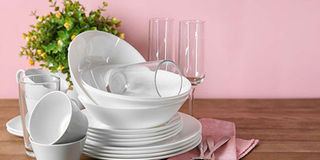Here’s what to consider while styling your dinnerware

All dinnerware is made from ceramic. Beneath ceramic is a subcategory of porcelain, stoneware, earthenware and bone china. PHOTO | FILE | NATION MEDIA GROUP
What you need to know:
- It is important that you know what material your dinnerware is made from because this determines its cost, utility for daily use and durability.
- Dinnerware in strong solid shades of colours - such as white or blue tends - to be more classic and versatile than dinnerware with artwork.
A crucial element of interior decor and styling that is often overlooked is cutlery and crockery – what you eat with and drink from, the dishes that you use daily with your family and those that you host guests with on special occasions.
It makes little sense to have a dining room that looks like it could feature on the cover of Elle Decor magazine yet have a random selection of school cafeteria cutlery and crockery.
The same way we think about styling our spaces is the same we should approach what ends up on our table.
Cutlery and crockery fall under a broad category of tableware. Today, we will focus on crockery, particularly dinnerware.
A standard dinnerware set has mugs, bowls, side plates and dinner plates. Some dinnerware come as a set of four (16-piece set), others five (20-piece) while others six (24-piece).
You can also have a variation, with some sets including a wide-rim bowl, a salad plate or a teacup that has a saucer.
Items that are usually not included in a dinnerware set are a serving bowl, a soup cup, gravy train, teapot... all these fall under a different category all together.
Some vendors stock individual pieces, giving you the freedom to customise your own dinnerware set. Others stock sets that must be purchased in their entirety, as is.
Stockists here include supermarkets, wholesale distributors, second-hand or antique vendors.
Before you go out to invest in dinnerware, here are some considerations to guide your purchase:
#1: Material
It is important that you know what material your dinnerware is made from because this determines its cost, utility for daily use and durability.
All dinnerware is made from ceramic. Beneath ceramic is a subcategory of porcelain, stoneware, earthenware and bone china. Porcelain is what we are most familiar with.
It is usually white, plain or sparsely decorated, smooth to the touch and somewhat feels thin. All porcelain has a glazed finish.
Stoneware is heavier and thicker than porcelain, and comes in a variety of colours and motifs. Some stoneware is glazed, making it appear like porcelain.
Bone china is a more delicate, posh form of porcelain, it is what most fine dining restaurants use.
Earthenware appears to be moulded by hand from unrefined clay, rarely is it glazed, and is dyed to give it different colours.
Porcelain and stoneware are the most common on our shelves. Porcelain is prone to hairline fractures and spoon marks. Stoneware can be uncomfortably heavy to hold and easily chips.
Porcelain tends to be costlier than stoneware.
#2: Colour and artwork
You can go for dinnerware in solid colours such like cloud white, midnight black, navy blue and turquoise, or you can go for some with artwork such as flowers, geometric lines, abstract shapes, polka dots, insects, marine life and whatnot.
The type of colour and artwork you settle for is really a matter of personal choice. However, dinnerware in strong solid shades of colours - such as white or blue tends - to be more classic and versatile than dinnerware with artwork.
Furthermore, they outlive trends and somehow make food on it look more delicious. It is also easier to mix and match - and build from – a solid white set than it is a set with motifs.
I suggest you get classic cloud white sets for entertaining your guests, and open stock pieces with motifs for your daily use.
That is, a set of six matching bowls and dinner plates, and a separate set of six non-matching mugs.
#3: Utility and daily use
Select dinnerware that can withstand daily use and give you value for your money. The questions to ask about utility are questions such as: do the mugs begin to get coffee and tea stains after a few months of use?
Do the items chip as they are drying on the dish rack, or after being knocked against a surface? Do the plates show knife and spoon marks?
Are the pieces microwave safe? Can you comfortably hold a mug that has hot cocoa, or will it scald you?
The questions about staining, chipping and showing spoon marks can only be answered with your experience from your dinnerware; it matters not how hardy the material is, whether porcelain or stoneware, the proof of the pudding is in the eating.
This is because there are some stoneware pieces that chip easily and others that can withstand a gentle fall.
Some porcelain pieces we leave behind in our childhood homes, others crack in the microwave of our own homes on the first use.
#4: Shape
Modern dinnerware does not follow the conventional rule that all household dinnerware must be round.
There are now plates that are rectangular, triangle and oblong. There are also square bowls, saucers shaped in the letter ‘S’ and oval cups with unusual handles.
While such dinnerware is fun to experiment and host with, it may not be practical for everyday use.
Imagine trying to warm a meal in a large square plate that will not fit in the microwave. Or trying to enjoy a meal of beefy fry and rice from a small-rim triangular plate that barely allows you to pinch portions as you would with your regular shaped plates.
Go for regular shapes with your daily-use and hosting dinnerware, have another set with irregular shapes for those days when you want to go extra.





